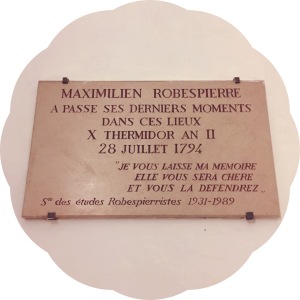Isn’t it odd how we pay less attention to sights on our own doorstep than we do to unfamiliar ones, even when our local attractions are more beautiful, unusual or remarkable? We all do it. Part of it must be that we become desensitised to the beauty around us when we see it every day, when it becomes our norm. Part of it must be the sense that because we pass something constantly, we will have infinite chances in the future to stop and appreciate it. We’ll visit when work calms down. We’ll take photos when we’re in less of a rush. We’ll enter and read and learn about our local history when we finally have an afternoon free. But when we’re travelling, we open our eyes wider, making that extra effort to soak it all up, perhaps because we feel like we might not get another chance to do so.

For two years, la Conciergerie, a 14th-century complex which was once a royal palace and then a series of prisons, was the closest museum to my Paris apartment. I would walk past the ornate entrance almost every day, as I crossed over the Ile de la Cité from my flat on the rive droite to my campus on the gauche. The boulevard du Palais was the most direct walking route to the bookshops and cafes of the fifth arrondissement where I wrote so much of my thesis. Passing by the Conciergerie was a normal part of my day, a moment in my regular PhD routine. The only real attention I paid to it was to stop every so often to photograph the incredible clock on the corner, the oldest public clock in Paris, built in the 1300s and lavishly refurbished in 2012:

Frequently, I would see the long lines of dedicated tourists outside the entrance and would make a mental note to visit… one day. But it wasn’t until I’d moved out of the area that I finally made my way to the Conciergerie. Immediately upon entering, I couldn’t believe I’d waited so long to do so.

Through the gates, what had seemed like a small site opens up to a huge stone palace, where the monarchy once lived, then where they kept their prisoners, then where the revolutionaries kept the monarchy, then where Robespierre kept his real and perceived enemies, and finally where Robespierre was kept before losing his head in the same way so many others lost theirs under his control. The space is quiet, spare, uncluttered, even peaceful, despite its violent past and location in the very heart of the city. The chapel of Sainte-Chapelle in particular is a stunning oasis, perhaps the most beautiful collection of stained glass I’ve ever seen, illuminated by sunbeams and chandeliers.

The Conciergerie is a capsule of history, showing traces of the disparate and overlapping regimes that controlled the France of the 18th century. Marie Antoinette’s chamber, where she was imprisoned in the final months of her life before being guillotined in 1793, is mere steps away from the plaque marking where Robespierre spent his final hours before meeting the same fate less than a year later.

The Conciergerie is a sanctuary in the bustling centre of Paris. Its sparse stone walls were host to a history of violence and upheaval, but it is a surprisingly serene place in which to ponder the past. This museum is well worth braving the queue. I only wonder why I took so long to do it myself.